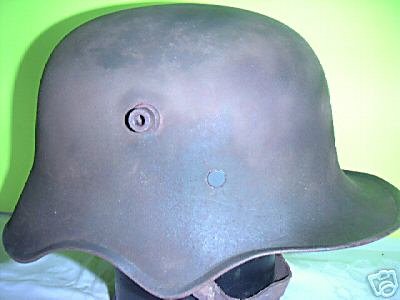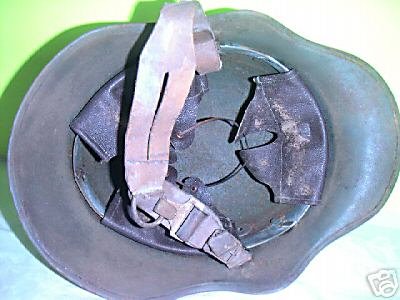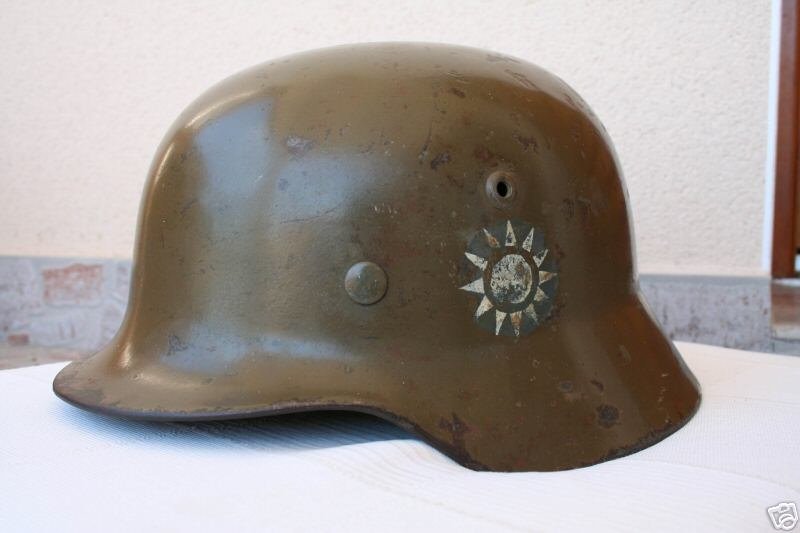Friday, October 20, 2006
希特勒生日郵票
Saturday, October 14, 2006
德軍騎兵用M18切耳 鋼盔 M18 ear cut out helmet

Stahlhelm M18 Kavalerie mit Emblem,komplett mit Leder-liner auf Stahlrahmen und Kinnriemen,Kascogröße ca.66,Kopfgröße ca.58,Farbe Heeresgrau teilweise abgescheuert,Der Stahlhelm hat keine Löcher,keine Beulen,keine Risse,möglicherweise überarbeitet,guter Zustand.
M18 ear cut out helmet
The first "modern" steel helmets were introduced by the French army in early 1915 and were shortly followed by the British army later that year. With plans on the drawing board, experimental helmets in the field, ("Gaede" helmet), and some captured French and British helmets the German army began tests for their own steel helmet at the Kummersdorf Proving Grounds in November, and in the field in December 1915. An acceptable pattern was developed and approved and production began at Eisen-und Htenwerke, AG Thale/Harz, in the spring of 1916. These first modern M16 helmets evolved into the M18 helmets by the end of WWI. Ongoing research and evaluation of the M16 and M18 helmets and complaints from the field that the side aprons of the helmets caused a hearing obstruction resulted in the introduction of the M18 "ear cut-out" helmet in August 1918. These special M18 "ear cut-out" helmets were manufactured by the Eisen-und Htenwerke, firm in Thale/Harz and were only produced in size 64, (the most common size), in limited quantities. At the end of WWI it is estimated that Germany had produced about 8,500,000 steel helmets. As a result of the restrictions placed on the German by the Treaty of Versailles, which dictated a standing army of only 100,000 personnel, there was an abundant surplus of these helmets, and though they saw widespread use by Freikorps personnel, there was still a stockpile controlled by the Reichswehr. These excess helmets underwent minor modifications in 1923 with the addition of provincial identifying shield decals and in 1931 with the development of a new chinstrap and liner system. Although helmet development was ongoing when Hitler came to power in 1933, the M16 and M18 helmets were still the main headgear worn by the Reichswehr. The helmets remained the same until March 1933 when the provincial shields were discontinued in favour of the national tri-color shield. In 1934 the national eagle shield was introduced, and both the tri-color and eagle shields were applied to the helmets. After the development of the new M35 helmet the WWI helmets were still issued to second line and training troops well into WWII. The M18 "ear cut-out" helmet followed the same basic transition as the other WWI helmets after the war, and was manufactured early in the Third Reich period, in limited quantities, with the last issuance being to Cavalry personnel. Officers and certain senior NCO ranks were responsible for purchasing their own headgear and as a result were allotted a clothing allowance through the army Kleiderkasse, (Clothing Account), system. Officers and Officials with the equivalent position of an Officer also had the option to privately purchase light weight, aluminum or vulcanfiber construction "parade" helmets. The light weight helmets were officially designated Leichtehelme, (Light Helmet), and regulations dictated that they were only permitted for wear with the parade dress when the Officer or Official was not in unit formation.




